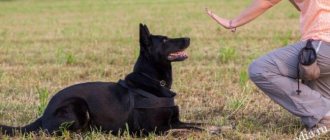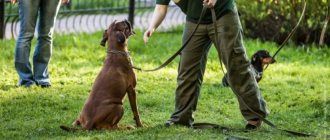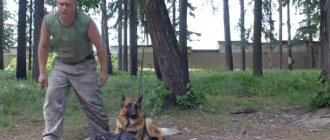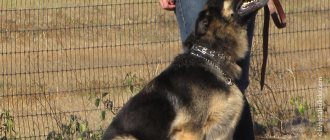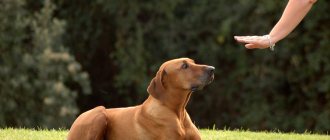The command “Bunny” or “Serve” is that the dog sits on its hind legs, raising its front legs. This is a fairly popular exercise, but not all dogs can do it. This trick is most suitable for small dogs with short backs, as it is easier for them to maintain balance. Large dogs and those with spinal problems find this exercise difficult.
How to teach your dog the “Serve” command
or
“Bunny”?
Very simple: say “Sit” and bring a treat to her nose.
Showing the dog a treat
Slowly raise your hand with the treat just above the dog's nose, and then move your hand slightly back behind the animal's head. If your pet stands up when reaching for a treat, correct him. Give the treat as soon as the dog sits with a straight back.
We pass a treat behind the head to encourage the dog to rise
You can attach the leash and gently pull the dog into the desired position. But under no circumstances pull your dog on a leash.
Repeat the exercise several times and enter the voice command “Bunny” or “Serve” when the dog understands the essence of the trick and will take the desired position without any problems.
The dog sits in the “Bunny” position
At first, it is enough for the dog to sit with his back straight for a few seconds. To teach your dog to do the “Bunny” without your help and freeze in this position for a long time , repeat the exercise several times, gradually increasing the intervals between the execution of the command and the reward.
"Serve" for small dogs.
Large pets learn to “Serve” somewhat differently than small breeds. The algorithm by which you can teach your pet to stand up is as follows:
- The command “Sit” is given.
- The owner stands facing the dog and gets down on one knee.
- With the help of a treat, the owner of the animal forces the dog to lift its head.
- Then he pulls the hand with the treat up so that the dog lifts its front paws off the floor.
- The command “Bunny” or “Serve” is given.
- The pet is treated to a treat.
Before rewarding the dog after performing the stand, you need to wait until the pet finds balance on its hind legs and stands in this position for a while. To train a dog to “Serve” fully, it is necessary to gradually increase the time spent in the stance and quietly move a short distance away from the pet.
When should you start training your puppy?
Any dog handler will answer this question this way: the sooner the better. However, it is worth considering that due to age factors, there are restrictions for some teams. Basic elements of training and education must be applied from about three months of age of the pet. After the dog has mastered them and can carry them out without any problems, you can move on to more complex commands and tricks. As a rule, by this time the puppy is 6-7 months old.
However, it is necessary to take into account the individual characteristics of the dog, the characteristics of the breed, its temperament and character. Those commands that are easily performed by a German Shepherd or Alabai will be difficult for a Dachshund or Pekingese, and they may take much more time to master. Therefore, it is very difficult to name the exact age for a specific team. In addition, the frequency and regularity of classes, the amount of time allocated for training, and the owner’s persistence play a role here.
“Serve” for large breeds.
Large breed dogs are much more difficult to train to “Serve” than miniature pets. A dog will never become an upright walker, so it is difficult for a large animal to maintain balance on its hind legs. Standard “Bunny” training here looks like this:
- The command “sit” is given.
- The owner stands behind the dog.
- With a treat, the dog is forced to lift its head and stand up for the treat.
- The pet is picked up under the paws by hand and commanded “Serve” or “Bunny”.
- Then they give the treat and praise.
Training a large dog involves supporting it with your hands in the first stages of training. An experienced dog handler may advise not to linger at this stage for too long, but to give the pet the opportunity to maintain balance on its own.
Another dog can show you how to do the bunny correctly. Training the “Bunny” should take place in a calm environment, where there are no cats, cats, or other irritants.
Basic and additional commands
All commands can be divided into two groups – basic (main or mandatory) and additional. The mandatory ones include the following:
- lie;
- stand;
- near (to me);
- sit;
- fu (impossible);
- place;
- walk;
- voice;
- stranger.
Having taught the pet these commands, the owner will be able to walk with him on the street without any problems, go to visit, visit crowded places, without fear that the dog will harm anyone or create an unpleasant situation.
Additional ones include:
- to guard;
- bunny (to serve);
- to spin;
- "ashamed";
- fetch;
- trench (the pet crawls under logs or other obstacles);
- seek;
- other.
Depending on the breed and the needs of the owner, the list of commands and tricks performed by the dog can be continued for a very long time. The main thing is to understand whether your pet needs these complex skills in everyday life. For example, raising service dogs and small pets will be radically different, in particular, the list of additional commands will be much larger.
Have you already tried it and it doesn’t help?
Enroll in an online school and solve your problem right now!
more details
Many people are interested in how to teach a dog the bunny command? We will talk about this in more detail later in our article.
“Serve”: working on mistakes.
Effective correction of a pet's behavior occurs gradually. If the pet does not understand what is required of it, then only a canine psychologist can help. Some animals are shy and are simply afraid to stand on their hind legs.
While executing the command, you need to make sure that the dog’s body does not fall on its side. The vertical position of the back when performing “Serve” is considered preferable. It is worth remembering that this trick can only be mastered by dogs that have no health problems and whose back is not a sore spot.
At what age should you train a dog?
It is worth applying training to a puppy from an early age, from about three months. It is during this period that the puppy becomes weaned from its mother and becomes attached to its owner and begins to trust him, after a short adaptation. You should not learn to execute commands all at once, but one at a time, regularly complicating them.
Many people are interested in whether it is possible to train an adult dog that has not been trained before? Many dog handlers say that it is possible. But this will take much more time and effort than raising a small puppy. After all, an adult dog has already formed its own habits and principles of interaction with others, and retraining it is a difficult job. But, if you were able to win the dog over, establish contact and mutual understanding, you can count on a positive result from your efforts. The dog will learn to follow any commands and will delight you every day.
The "serve" command. When should it be taught?
There are a number of commands that are considered mandatory for every dog. There are also additional, more complex ones, which are taught to dogs who have completed the initial training course. This includes the command to serve. It is necessary to teach an animal this command when it has mastered the basic ones, namely:
- sit;
- lie;
- stand;
- near;
- place;
- voice;
- ugh;
- walk;
- stranger;
- bring it.
The dog should carry out these commands on an intuitive level, without hesitation. This is achieved through intensive and, most importantly, regular training, with the obligatory encouragement of the animal when performing each task. When the dog understands these tasks without any problems and completes them, you can move on to other, more complex commands, such as serve.
Features of training an adult dog
It is more difficult to teach an adult dog commands than a puppy, but it is not impossible. However, it is necessary to understand: an adult dog that has not undergone socialization may have a formed psyche and ingrained habits, and the question in this case is not about training, but about adjustment or re-education. The ability to rebuild a behavior model depends on the dog’s temperament, its age, and degree of aggressiveness.
If it is obvious that you cannot cope on your own, you need to seek help from a professional. Modern training techniques in the hands of a good specialist work wonders.
The basic principles of training adult dogs remain the same:
- Training goes from simpler to more complex commands.
- In parallel, hierarchical settings are established. In sexually mature individuals, additional motives for developing dominant behavior associated with reproductive instincts are included, therefore, in a situation with an adult dog, it is extremely important to show the dog clear boundaries of what is permitted.
- Training should be systematic: even refined commands must be repeated periodically.
- It is important to be able to restrain emotions: fear, anger, aggression, impatience are not acceptable.
- Reinforcement follows immediately after a successfully completed command. Failure is accompanied by indifference and lack of reaction on the part of the owner.
As in the situation with young dogs, it is necessary to carefully observe the process, not to overtire the pet, learn to sense his mood, and most importantly, take his time.
Other training options for “Bunny” (“Serve”)
You can teach your dog the “Serve” command in other ways. If your pet has trouble maintaining balance, try the following training options:
- Option 1: Let the dog lean on your hand, which is holding a treat. When the dog begins to understand the essence of the exercise, gradually remove your hand and teach him to raise his paws in the air without your help.
The dog leans on the hand to maintain balance
- Option 2: Place the dog in the corner of the room close to the walls so that they provide additional support. Then use treats to force the animal into the desired position.
Walls help dogs balance
- Option 3: Tell your dog to “Sit” and stand behind him as close as possible (heels together, toes apart, knees supporting the animal’s back). Use treats to encourage her to get up.
The pet performs “Serve”, relying on the trainer.
Source
How to teach a puppy the bunny command
How to teach a dog to do the “bunny” and “bow”
Almost no performance at dog dancing competitions is complete without these two elements, since they are quite impressive when performed and are easy to teach to your pet. Polina Ilyina talks about how to learn them correctly.
When teaching a dog the elements of “bunny” (or, as they say in the circus, sitting on “Of!”) and “bow,” the trainer holds the treat in the hand in which he is most comfortable.
Let's start by learning the "bunny" skill.
In order for a dog to successfully perform this trick, he needs to learn to maintain balance while his back is in an upright position.
I sit the four-legged one exactly in front of me. Then I bring my right hand to the dog’s nose and begin to slowly lift the piece up so that he does not stand up, but only lifts his front paws off the ground. As soon as this happens, I praise the animal and feed it a treat. After this, we try to raise our hand so that the dog’s back is in a vertical position perpendicular to the ground.
To maintain balance, the dog may also wrap its front paws around your hand. Large breed dogs can first be placed with their front paws, for example, on a stool or, if they started training outside, on a bench, so that it is easier for them to strengthen their back muscles.
Another option for help: sit the dog down and stand (as close as possible) behind its back. Then, as shown in the photo, we lift the dog with the help of a seductive piece so that he stands in the “bunny” position and rests his back on the handler’s legs.
When the dog has firmly learned that behind the hand that moves up from its nose, you need to rise vertically without standing up on your hind legs, I enter a command, for example, “Bunny!” I say the command “Bunny!” and “raise” the dog, after which I praise and give the treat.
At this stage I give the command “Bunny!” and gradually move my hand away from the animal’s muzzle. When the dog manages to climb into the “bunny” position, I praise him and reward him with a treat.
Next, the trainer learns the skill without bending down towards the dog, using only a hand gesture. So, we give a signal with our right hand, give the command and wait. If the pet immediately did everything correctly, following the hand, we actively encourage him with a voice and a piece of treat. If the task is still difficult for the dog, then you can bend over a little and move your hand a little closer to it, “suggesting” the desired solution. But if the previous stages are worked out correctly, difficulties usually do not arise.
Now that the dog has learned to easily and quickly rise into the “bunny” position on command, maintain good balance and remain in this position in front of the handler for a long time, you can complicate the exercise. We try to start moving in front of the pet. To prevent the animal from immediately changing position, you can hold a piece of treat in front of its muzzle and at this moment begin to carefully step with your feet in place. If the dog remains in the desired position, you can give a piece of treat. Then, holding the treat in the same way, you can begin to take large steps away from the animal and eventually walk around it completely. If everything went well, you can begin to gradually move your hand with the treat away from the dog’s face. If the previous steps are worked out correctly, it will be possible to completely remove your hand from the dog’s nose quite quickly.
Why does a dog need to know commands?
Commands need to be taught so that the pet can live normally with other animals and people, especially for large and fighting breeds. Although small dogs without training can grow up to be no less aggressive and uncontrollable. Training is also necessary in order to correct behavior, eradicate bad habits, and develop the animal’s natural instincts.
Is it possible to train an adult dog? It is possible, but much more difficult, so it is better to start classes from six months of life, although they are carried out in a playful way. The process will go much faster, as puppies are more active and love to learn new things.
But before starting classes, you need to consider the following points:
- the character and habits of the pet;
- prioritize;
- do not retreat from classes, make them permanent;
- praise and encourage the puppy, make exercises more interesting;
- distinguish between work and play moments.
It is also important to take into account that exercises do not need to be done after lunch or dinner, and training should only be carried out on an empty stomach.
Training a mongrel
No one has yet created a special treatise “How to train a mongrel dog,” because the basic principles of training are the same as for other representatives of the canine community. Purebred dogs have genetic characteristics, according to which some pets tend to protect the territory, while others tend to conduct search work.
Mongrel dogs have a lot in their blood that no one is aware of, and many of them are much smarter than representatives of “high society.” If there is an exotic dog and a mongrel one on the street, the chances of success in survival will undoubtedly be on the side of the latter.
As with any other pet, it is correct to start training a mongrel from puppyhood (3-4 months), following the basic rules of training.


